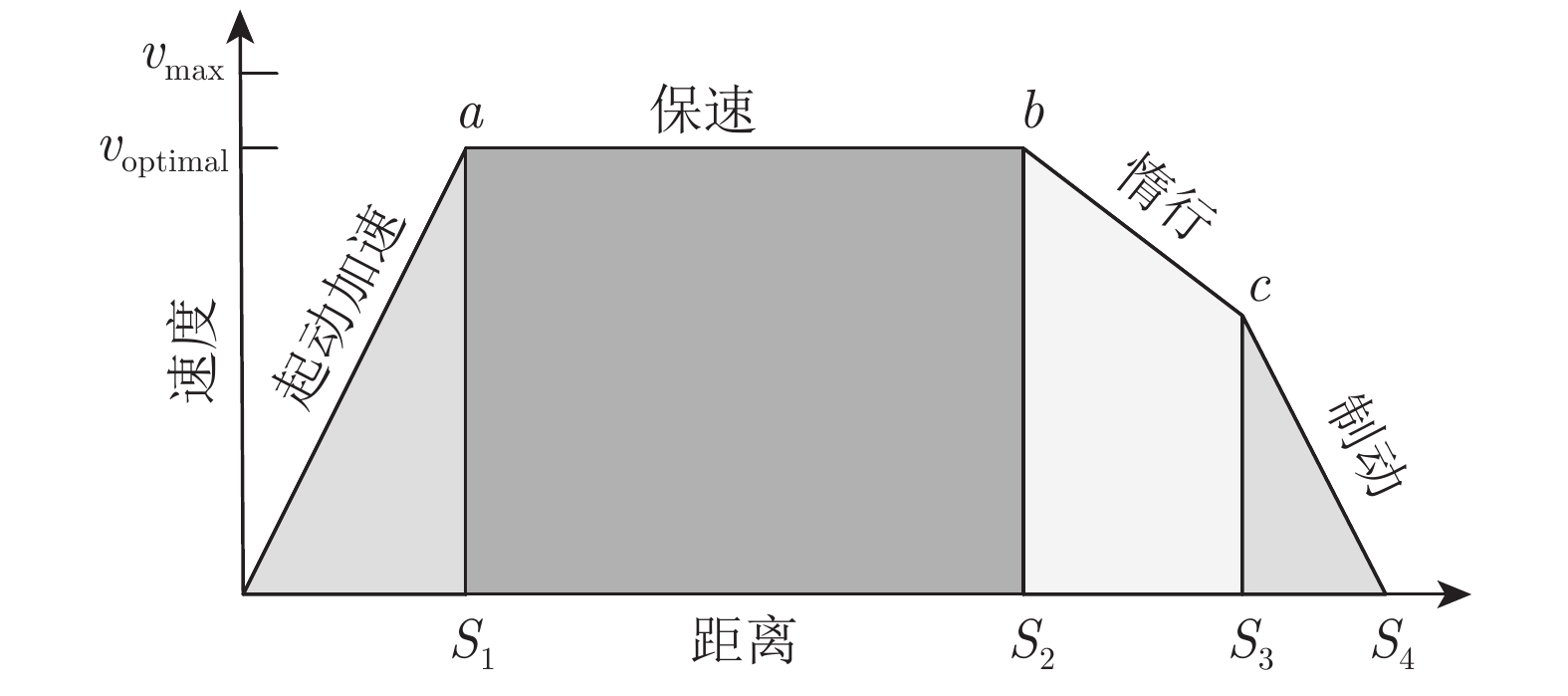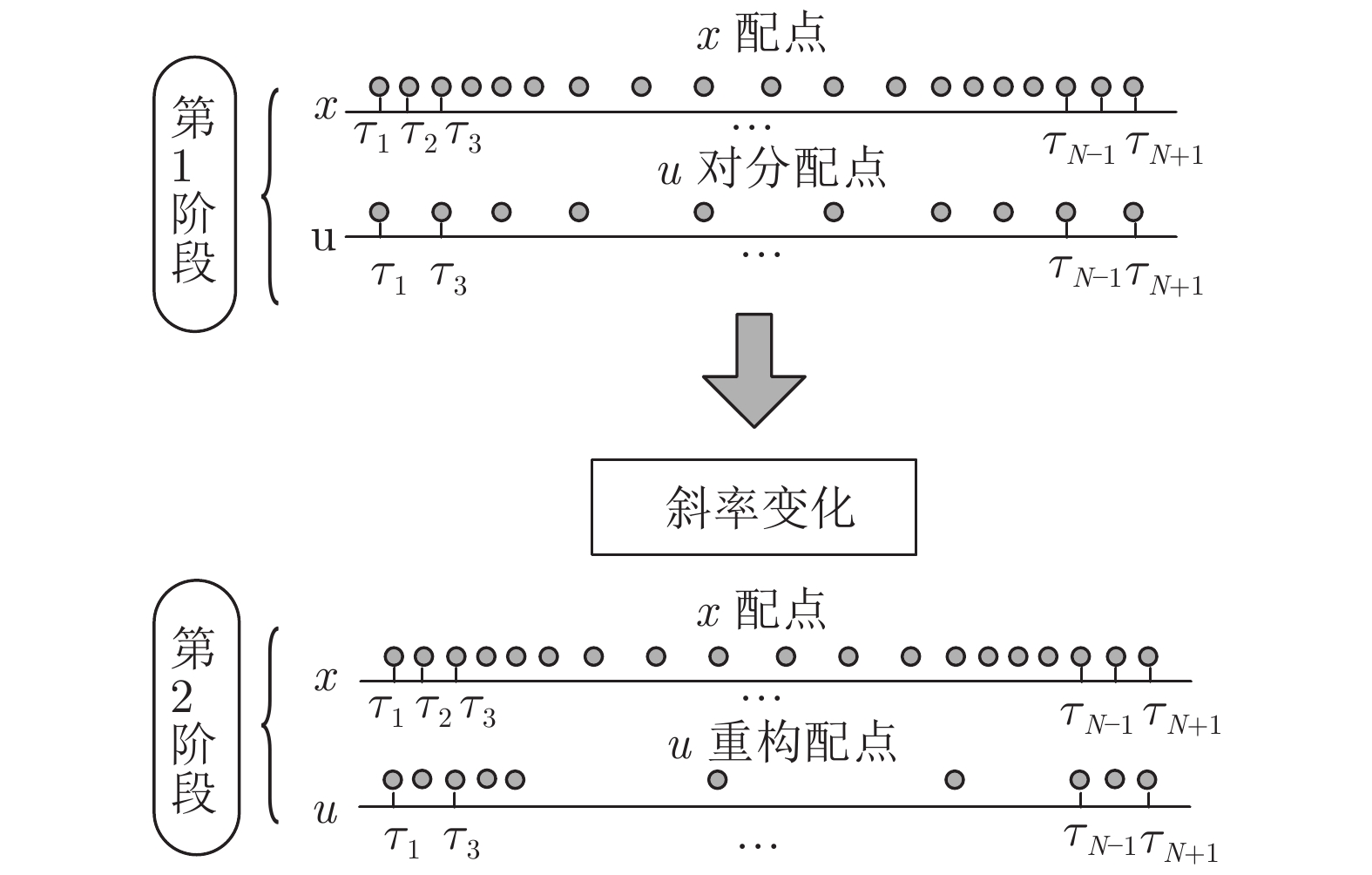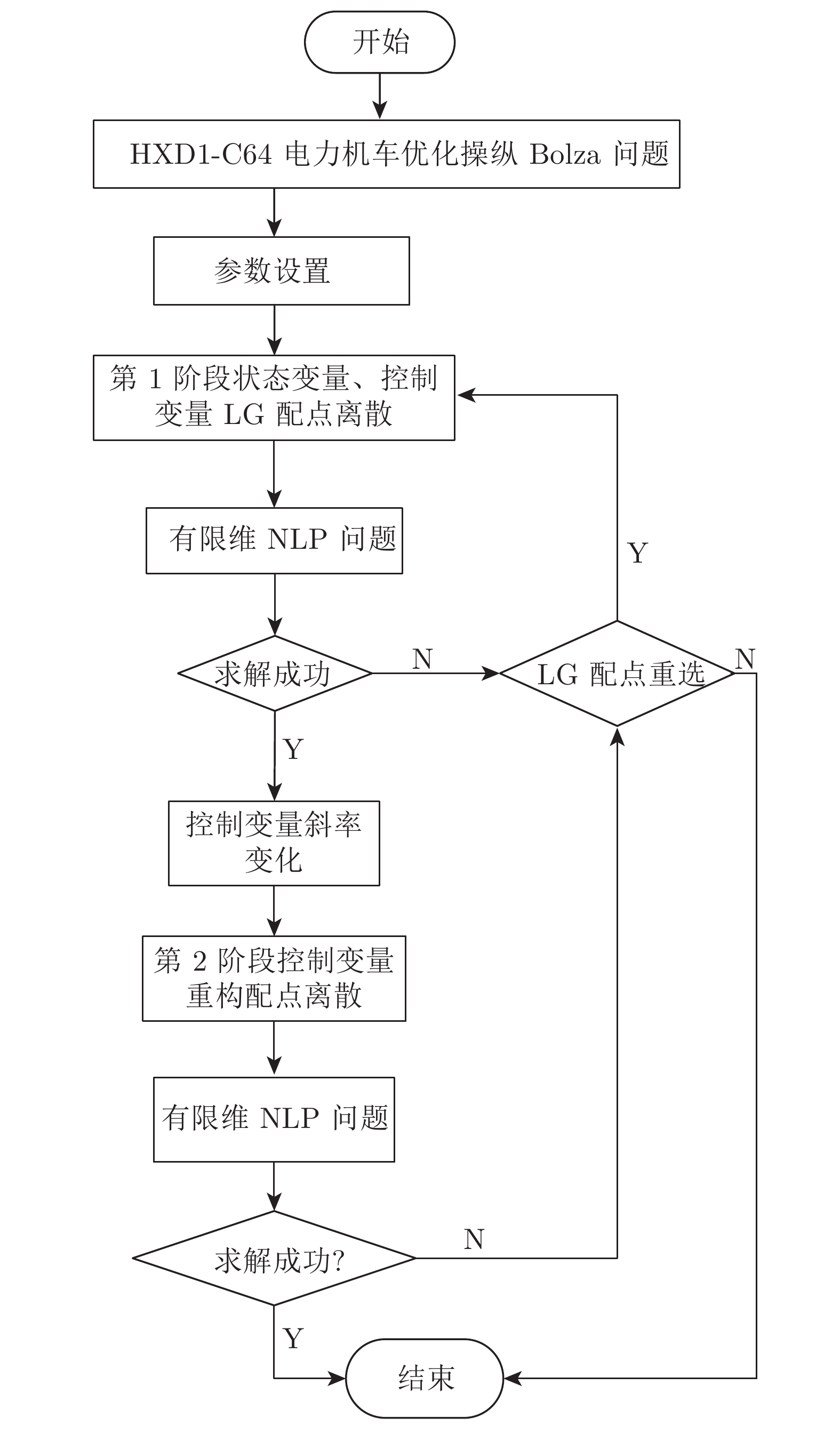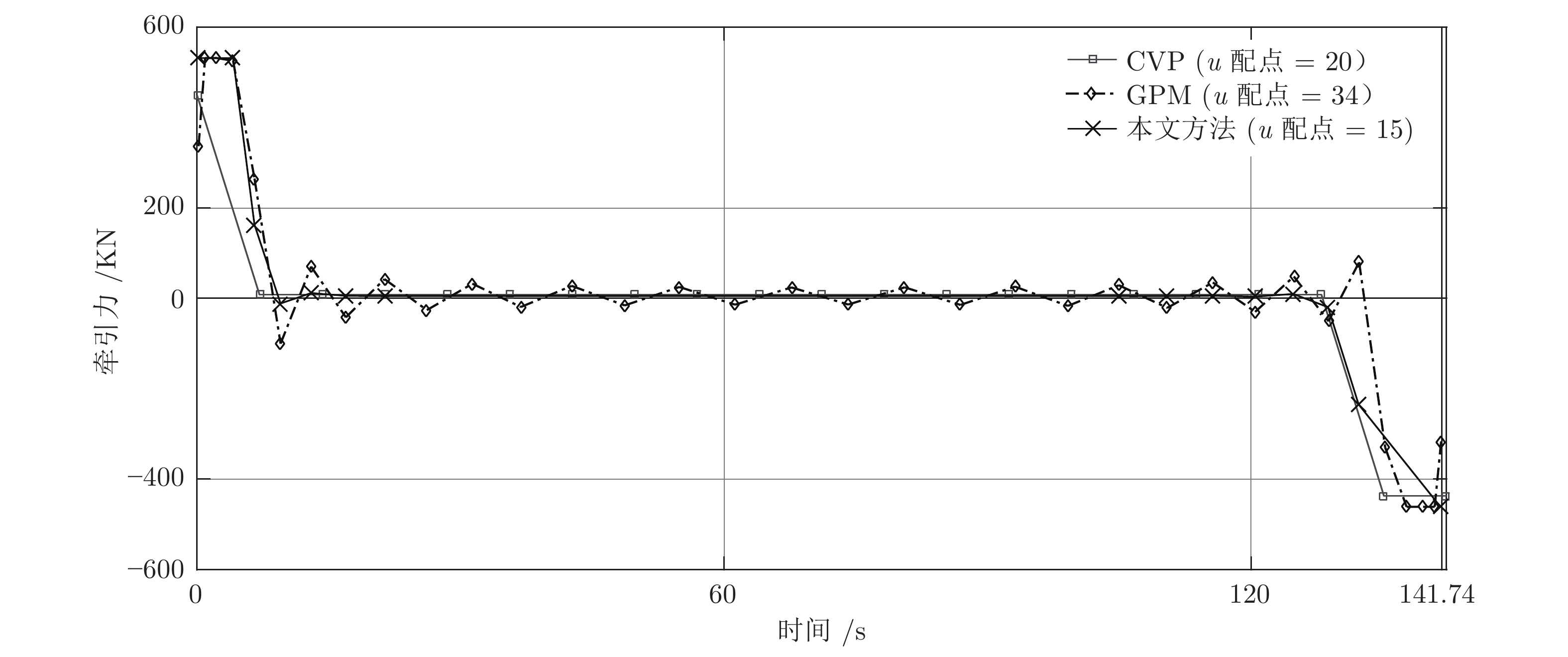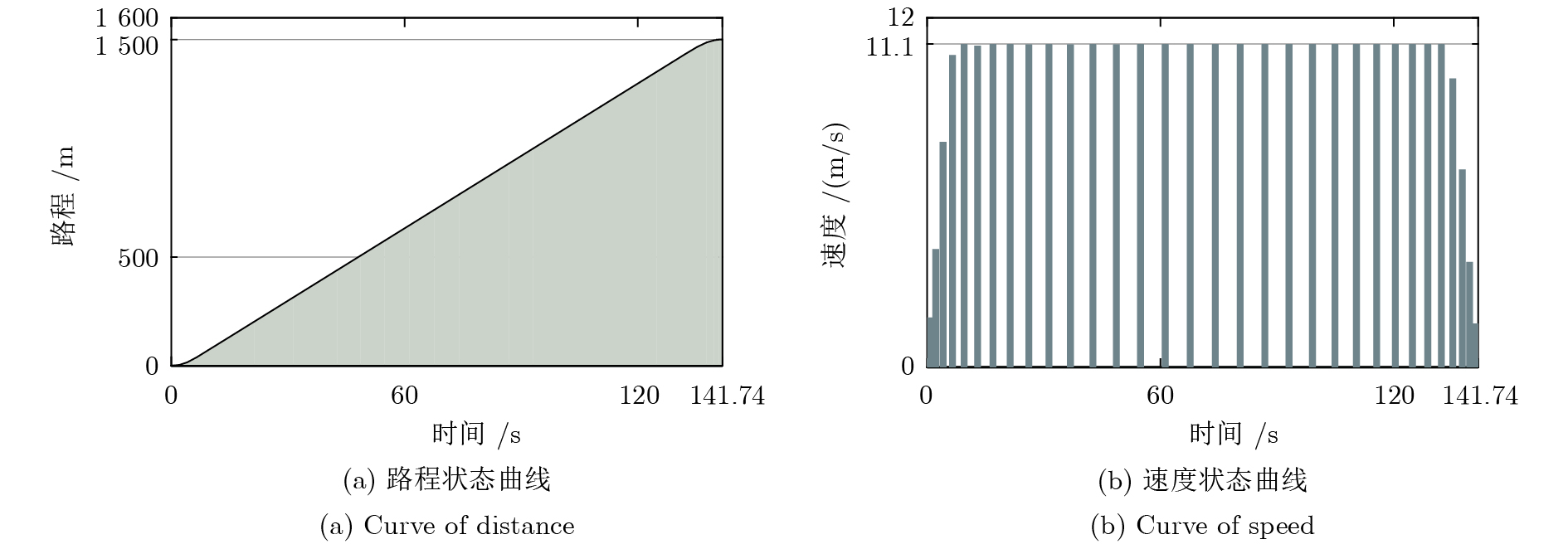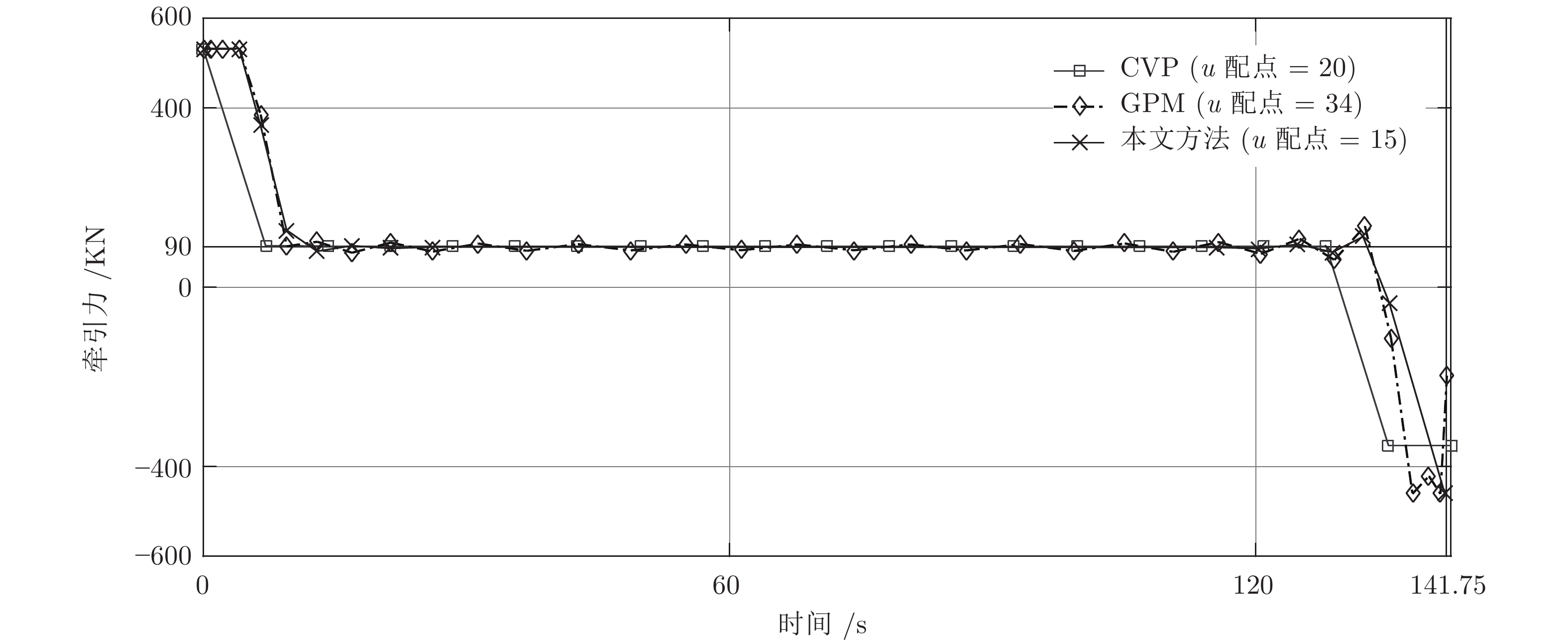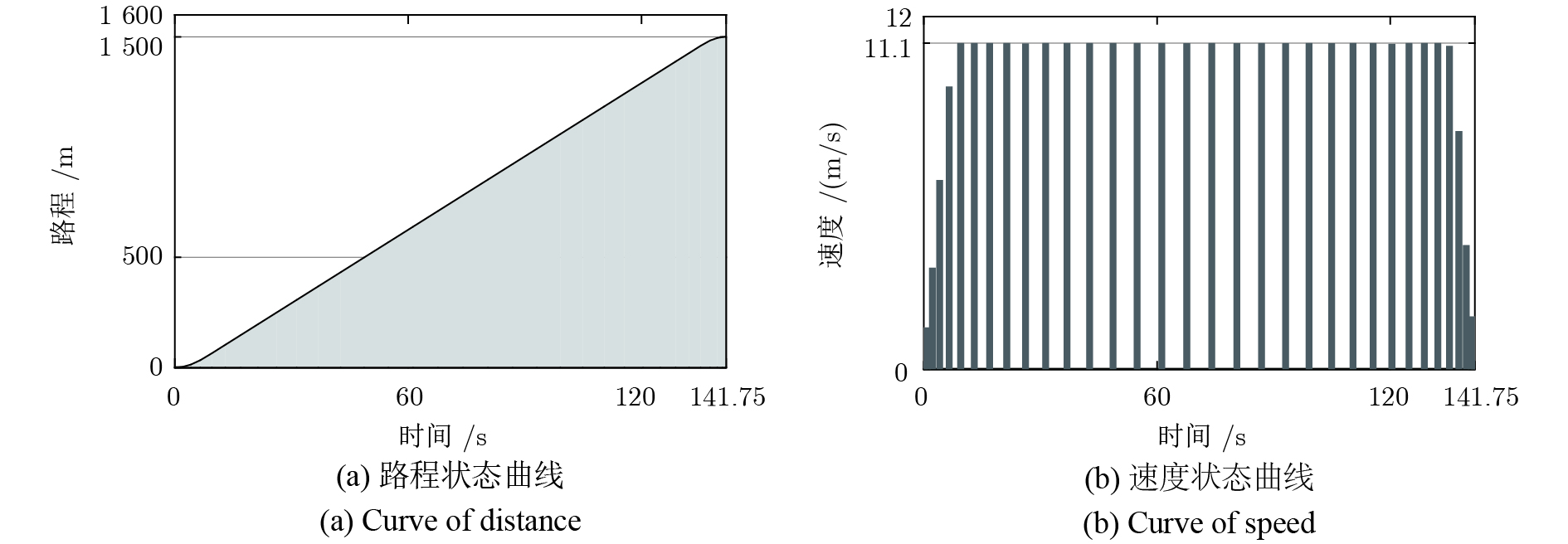Optimization Operation of Electric Locomotive Based on Two-stage AdaptiveGauss Re-Collocation Pseudospectral Approach
-
摘要: 针对中车株洲电力机车有限公司设计的HXD1-C64电力机车, 提出一种基于两阶段自适应Gauss配点重构的伪谱法, 用于列车优化操纵问题高效快速求解. 首先, 建立了HXD1-C64电力机车优化操纵数学模型; 然后, 在推导Legendre-Gauss配点公式的基础上, 给出控制变量两阶段自适应Gauss配点策略, 第1阶段采用对分配点, 第2阶段引入斜率变化分析对控制变量配点进行自适应细分和合并; 最后, 在运行时间最短目标下对HXD1-C64电力机车优化操纵进行仿真实验. 结果显示, 相较于控制变量参数化方法和传统高斯伪谱方法(Gauss pseudospectral method, GPM), 改进方法获得了更优性能指标和牵引力控制品质, 计算时间分别减少91.93 %和33.88 %, 表明了所提方法的有效性.
-
关键词:
- HXD1-C64电力机车 /
- 优化操纵 /
- 两阶段Gauss配点重构 /
- Gauss伪谱法
Abstract: A two-stage adaptive Gauss re-collocation pseudospectral approach is proposed for solving optimization operation problems of HXD1-C64 electric locomotive designed by CRRC (China Railway Rolling Stock Corporation) Zhuzhou Institute Co., LTD. Firstly, the optimization operation mathematical model of HXD1-C64 electric locomotive is established. Next, the Legendre-Gauss collocation formula is derived and then a two-stage adaptive Gauss collocation strategy is given, where a dichotomy collocation is adopted in the first stage and a slope change rate analysis is introduced in the second stage to adaptively subdivide or eliminate control variable collocation points. Finally, the simulation tests are carried out on HXD1-C64 electric locomotive to achieve time minimum operation. Simulation results show that the improved method obtains better performance index and traction control quality, compared with the control variable parameterization algorithm and the traditional Gauss pseudospectral method (GPM), while the computational time decreases by 91.93 % and 33.88 %, respectively, revealing the effectiveness of the proposed approach.1) 控制科学与工程学院工业控制技术国家重点实验室 杭州 310027 1. Key Laboratory of Industrial Wireless Network and Networked Control, Key Laboratory of Intelligent Air-Ground Cooperative Control for Universities in Chongqing, College of Automation, Chongqing University of Posts and Telecommunications, Chongqing 400065 2. China Railway Rolling Stock Corporation (CRRC) Zhuzhou Institute Co., LTD, Zhuzhou 412000 3. State Key Laboratory of Industry Control Technology, Col-lege of Control Science and Engineering, Zhejiang University, Hangzhou 3100272) 收稿日期 2019-03-20 录用日期 2019-07-17 Manuscript received March 20, 2019; accepted July 17, 2019 国家自然科学基金 (61803060, 51705050), 重庆市教委科学技术研究项目 (KJQN201800635, KJQN201804306), 工业控制技术国家重点实验室 (浙江大学) 开放课题 (ICT1900359) 资助 Supported by National Natural Science Foundation of China (61803060, 51705050), Science and Technology Research Program of Chongqing Municipal Education Commission (KJQN201800635, KJQN201804306), and Open Research Project of the State Key Laboratory of Industrial Control Technology of Zhejiang University (ICT1900359) 本文责任编委 阳春华 Recommended by Associate Editor YANG Chun-Hua 1. 重庆邮电大学自动化学院工业物联网与网络化控制教育部重点实验室、智能空地协同控制重庆市高校重点实验室 重庆 400065 2. 中车株洲电力机车研究所有限公司 株洲 412000 3. 浙江大学 -
表 1 HXD1-C64电力机车参数
Table 1 Parameters of HXD1-C64 electric locomotive
参数项 参数值 HXD1机车头质量 200 $\times10^3\;{\rm{kg} }$ C64 重车质量 84 $\times10^3\;{\rm{kg} }$ 粘着牵引力约束 $- 461\;{\rm{kN} } \leq {F_u}(t) \le 532\;{\rm{kN} }$ 路程约束 $s(t) = 1\;500\;{\rm{m} }$ 速度约束 $0 \leq v(t) \leq 11.1\;{\rm{m/s} }$ 表 2 HXD1-C64电力机车仿真实验1结果对比
Table 2 Numerical results comparison of Test 1 for HXD1-C64 electric locomotive
方法 测试 u(t) 配点数 x(t) 配点数 离散方法 NLP 求解器 性能指标 (s) 求解时间 (s) CVP 1 20 − 统一网格 内点法 142.25 50.41 2 40 − 统一网格 内点法 141.81 210.63 传统 GPM 1 34 34 LG配点 内点法 141.81 8.12 2 48 48 LG配点 内点法 141.62 19.19 本文方法 阶段 1 17 34 两阶段自适应 LG 配点 内点法 141.74 5.77 阶段 2 15 34 阶段 1 24 48 两阶段自适应 LG 配点 内点法 141.59 12.09 阶段 2 17 48 表 3 HXD1-C64电力机车仿真实验2结果对比
Table 3 Numerical results comparison of Test 2 for HXD1-C64 electric locomotive
方法 测试 u(t) 配点数 x(t) 配点数 离散方法 NLP 求解器 性能指标 (s) 求解时间 (s) CVP 1 20 − 统一网格 内点法 142.26 63.01 2 40 − 统一网格 内点法 141.83 238.79 传统GPM 1 34 34 LG 配点 内点法 141.97 8.10 2 48 48 LG 配点 内点法 141.76 21.47 本文方法 阶段 1 17 34 两阶段自适应 LG 配点 内点法 141.75 5.66 阶段 2 15 34 阶段 1 24 48 两阶段自适应 LG 配点 内点法 141.67 12.60 阶段 2 15 48 -
[1] 1 González-Gil A, Palacin R, Batty P, Powell J P. A systems approach to reduce urban rail energy consumption. Energy Conversion and Management, 2014, 80: 509−524 [2] 仲维锋, 徐洪泽. 基于控制参数化方法的列车节能操纵优化研究. 铁道学报, 2017, 39(6): 72−79 doi: 10.3969/j.issn.1001-8360.2017.06.0102 Zhong Wei-Feng, Xu Hong-Ze. Energy-efficient train operation optimization using control parameterization Method. Journal of the China Railway Society, 2017, 39(6): 72−79 doi: 10.3969/j.issn.1001-8360.2017.06.010 [3] 周继续, 贺德强, 姚晓阳, 向伟彬, 陈二恒. 电力机车优化操纵国内外研究算法综述. 铁道科学与工程学报, 2015, 12(1): 177−183 doi: 10.3969/j.issn.1672-7029.2015.01.0293 Zhou Ji-Xu, He De-Qiang, Yao Xiao-Yang, Xiang Wei-Bin, Chen Er-Heng. Domestic and international algorithm analysis of electric locomotive operation optimization. Journal of Railway Science and Engineering, 2015, 12(1): 177−183 doi: 10.3969/j.issn.1672-7029.2015.01.029 [4] 4 Zhao X H, Ke B R, Lian K L. Optimization of train speed curve for energy saving using efficient and accurate electric traction models on the mass rapid transit system. IEEE Transactions on Transportation Electrification, 2018, 4(4): 922−935 doi: 10.1109/TTE.2018.2851785 [5] 5 Azpilicueta L, Astrain J J, Lopez-Iturri P, Granda F, Vargas-Rosales C, Villadangos J, et al. Optimization and design of wireless systems for the implementation of context aware scenarios in railway passenger vehicles. IEEE Transactions on Intelligent Transportation Systems, 2017, 18(10): 2838−2850 doi: 10.1109/TITS.2017.2688858 [6] 荀径, 杨欣, 宁滨, 王义惠, 李坤妃. 列车节能操纵优化求解方法综述. 铁道学报, 2014, 36(4): 14−20 doi: 10.3969/j.issn.1001-8360.2014.04.0036 Xun Jing, Yang Xin, Ning Bin, Wang Yi-Hui, Li Kun-Fei. Survey on trajectory optimization for train operation. Journal of the China Railway Society, 2014, 36(4): 14−20 doi: 10.3969/j.issn.1001-8360.2014.04.003 [7] 7 Ichikawa K. Application of optimization theory for bounded state variable problems to the operation of train. Bulletin of JSME, 1968, 11(47): 857−865 doi: 10.1299/jsme1958.11.857 [8] 8 Ying W, Yuan G, Yu X, Hansen I A, Miao J. Optimization models for high-speed train unit routing problems. Computers and Industrial Engineering, 2019, 127: 1273−1281 [9] Liu R M, Li S K, Yang L X, Yin J T. Energy-efficient subway train scheduling design with time-dependent demand based on an approximate dynamic programming approach. IEEE Transactions on Systems, Man, and Cybernetics, Systems, 2019, DOI: 10.1109/TSMC.2018.2818263 [10] 10 Domínguez M, Fernández-Cardador A, Cucala A P, Gonsalves T, Fernández A. Multi objective particle swarm optimization algorithm for the design of efficient ATO speed profiles in metro lines. Engineering Applications of Artificial Intelligence, 2014, 29(3): 43−53 [11] 11 Luus R. Time-optimal control of state constrained linear systems. AIChE Journal, 1973, 19(6): 1262−1263 doi: 10.1002/aic.690190631 [12] 12 Liu P, Li X Y, Liu X G, Hu Y Q. An improved smoothing technique-based control vector parameterization method for optimal control problems with inequality path constraints. Optimal Control Applications and Methods, 2017, 38(4): 586−600 [13] 13 Lin Q, Loxton R, Teo K L. The control parameterization method for nonlinear optimal control: a survey. Journal of Industrial and Management Optimization, 2014, 10(1): 275−309 [14] 14 Zhang P, Chen H, Liu X, Zhang Z. An iterative multiobjective particle swarm optimization-based control vector parameterization for state constrained chemical and biochemical engineering problems. Biochemical Engineering Journal, 2015, 103: 138−151 doi: 10.1016/j.bej.2015.07.004 [15] 雍恩米, 陈磊, 唐国金. 飞行器轨迹优化数值方法综述. 宇航学报, 2008, 29(2): 397−406 doi: 10.3873/j.issn.1000-1328.2008.02.00215 Yong En-Mi, Chen Lei, Tang Guo-Jin. A survey of numerical methods for trajectory optimization of spacecraft. Journal of Astronautics, 2008, 29(2): 397−406 doi: 10.3873/j.issn.1000-1328.2008.02.002 [16] 16 Xiao L, Liu X, Ma L, Zhang Z. An effective pseudospectral method for constraint dynamic optimisation problems with characteristic times. International Journal of Control, 2017, 91(3): 1−11 [17] Han F, Wang Z L, He L, Wu H L, Yang G, Duan G R. Trajectory plan for an ultra-short distance on-orbit service based on the Gaussian pseudo-spectral method. IEEE/CAA Journal of Automatica Sinica, 2018, DOI: 10.1109/JAS.2017.7510892 [18] 18 Wang Y, Schutter B D, Boom T, Ning B. Optimal trajectory planning for trains-A pseudospectral method and a mixed integer linear programming approach. Transportation Research Part C Emerging Technologies, 2013, 29: 97−114 doi: 10.1016/j.trc.2013.01.007 [19] 19 Darby C L, Hager W W, Rao A V. An hp-adaptive pseudospectral method for solving optimal control problems. Optimal Control Applications and Methods, 2011, 32(4): 476−502 [20] 徐少兵, 李升波, 成波. 最优控制问题的 Legendre 伪谱法求解及其 应用. 控制与决策, 2014, 29(12): 2113−212020 Xu Shao-Bing, Li Sheng-Bo, Cheng Bo. Theory and application of Legendre pseudo-spectral method for solving optimal control problem. Control and Decision, 2014, 29(12): 2113−2120 [21] 21 Xiao L, Liu P, Liu X, Zhang Z, Wang Y, Yang C, et al. Sensitivity-based adaptive mesh refinement collocation method for dynamic optimization of chemical and biochemical processes. Bioprocess and Biosystems Engineering, 2017, 40(9): 1375−1389 [22] 22 Wang P, Goverde R M. Multi-train trajectory optimization for energy-efficient timetabling. European Journal of Operational Research, 2019, 272(2): 621−635 doi: 10.1016/j.ejor.2018.06.034 [23] Lide D R. Handbook of Mathematical Functions. Florida: CRC Press, 2018. [24] 24 Liu X, Hu Y, Feng J, Liu K. A novel penalty approach for nonlinear dynamic optimization problems with inequality path constraints. IEEE Transactions on Automatic Control, 2014, 22(2): 141−145 [25] 胡云卿, 刘兴高, 薛安克. 带不等式路径约束最优控制问题的惩罚 函数法. 自动化学报, 2013, 39(12): 1996−200125 Hu Yun-Qing, Liu Xing-Gao, Xue An-Ke. A penalty method for solving inequality path constrained optimal control problems. Acta Automatica Sinica, 2013, 39(12): 1996−2001 -





 下载:
下载:
